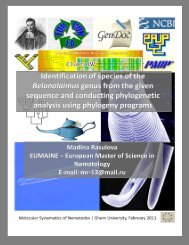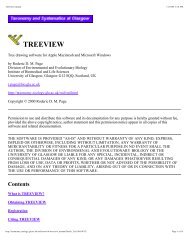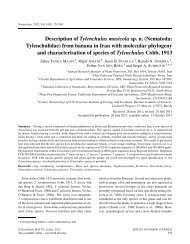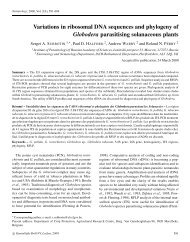Identification of cyst forming nematodes of the genus Heterodera ...
Identification of cyst forming nematodes of the genus Heterodera ...
Identification of cyst forming nematodes of the genus Heterodera ...
You also want an ePaper? Increase the reach of your titles
YUMPU automatically turns print PDFs into web optimized ePapers that Google loves.
S.A. Subbotin et al.<br />
Fig. 2. Restriction fragments <strong>of</strong> amplied ITS regions <strong>of</strong> <strong>cyst</strong> <strong>forming</strong> <strong>nematodes</strong>. A: EcoRI; B: HpaII; C: MvaI; D: PstI; E: RsaI; F:<br />
ScrFI; G: SfuI; H: TaqI. (For species code see Table 1; lanes U: unrestricted PCR product, M: 100 bp DNA ladder).<br />
(Fig. 1H), RsaI (Fig. 2E), TaqI (Fig. 2H), and Tru9I<br />
(Fig. 4). H. urticae, parasite <strong>of</strong> nettle in many West European<br />
countries, differed from H. carotae and H. cruciferae<br />
by RFLP patterns produced by three enzymes: Bsh1236I<br />
(Fig. 1C), HpaII (Fig. 2B), and Tru9I (Fig. 4). HpaII<br />
clearly differentiated H. urticae from <strong>the</strong>se two species. It<br />
did not digest <strong>the</strong> PCR product <strong>of</strong> H. carotae and H. cru-<br />
ciferae, but did restrict <strong>the</strong> ITS regions <strong>of</strong> H. urticae producing<br />
two fragments (870 and 190 bp).<br />
PCR ampli ed product obtained from H. oryzicola and<br />
H. cyperi differed from o<strong>the</strong>r species by its size. The<br />
digestion with different enzymes usually produced unique<br />
RFLP pro les for <strong>the</strong>se two species (Figs 1, 2, 4; Table 3).<br />
The unidenti ed <strong>Heterodera</strong> sp. from Cynodon dactylon<br />
160 Nematology
















